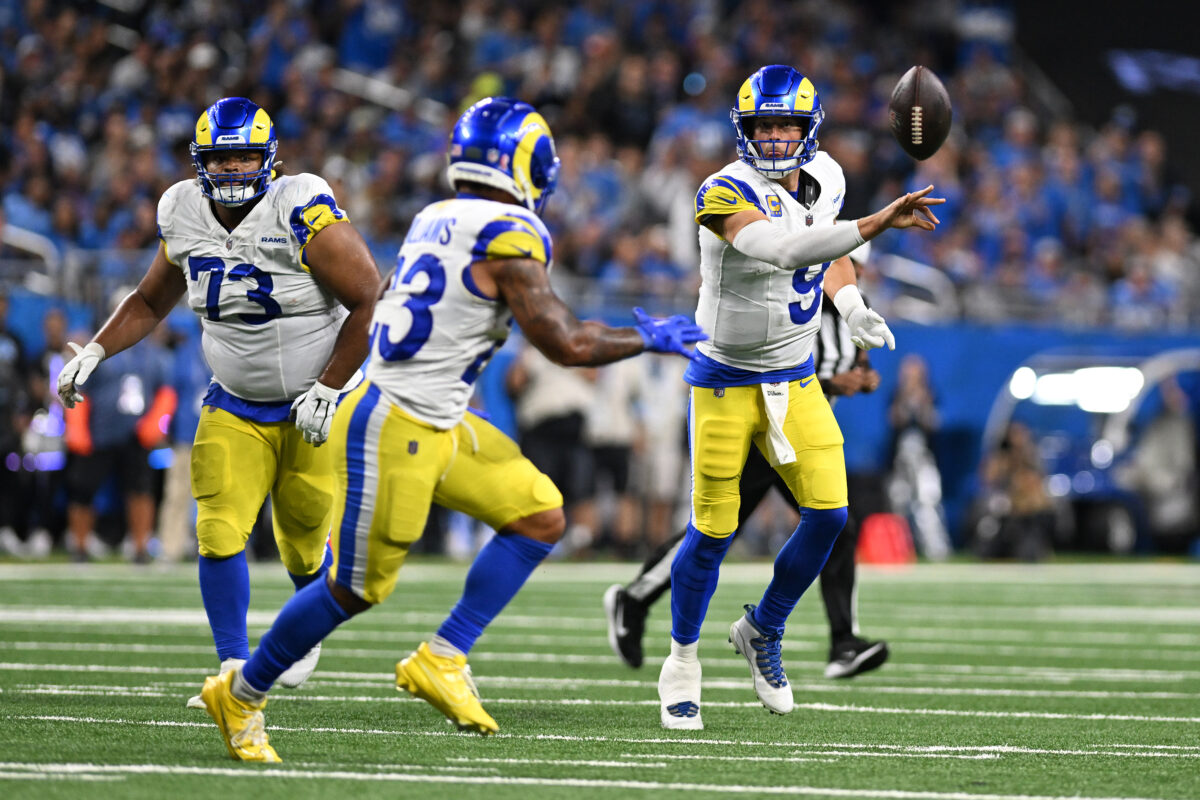Now more than ever, running backs are integral parts of an offense’s passing attack. Coaches have found that throwing to their backs can essentially be an extension of the ground game, whether it’s on swing passes or designed screens.
It’s an easy way to get the ball into the hands of one of your best playmakers without forcing him to take a pounding from defensive tackles by running it between the tackles. Plus, when a running back is in the open field against a cornerback, he can use his physicality to pick up yards after contact by breaking tackles.
As popular as running back targets have become, no one told Sean McVay about this trend. For whatever reason, he refuses to use his running backs as receivers and it’s a very simple element that’s missing from the Los Angeles Rams’ offense.
According to Fantasy Pros, the Rams have by far the lowest running back target rate of any team at just 9.6% this season. Every other team targets their running backs at least 13.1% of the time. By comparison, the Rams target their wide receivers at a league-high rate of 75.5%, and their tight end target share of 14.9% if the fourth-lowest in football.
Translation: The Rams are throwing to their wide receivers 3/4 of the time.
It’s not like this is a one-year thing for the Rams, either. Here are their running back target rates since 2017 and where they rank each year.
- 2017: 19.8% (21st)
- 2018: 17.8% (23rd)
- 2019: 10% (32nd)
- 2020: 12.6% (30th)
- 2021: 12.6% (32nd)
- 2022: 12.2% (31st)
- 2023: 12.4% (32nd)
- 2024: 9.6% (32nd)
You’ll notice there was a steep drop-off from 2018 to 2019, which is when Todd Gurley went from being an All-Pro to looking like a shell of himself due to a knee injury. Once Gurley fell off, the Rams stopped throwing to their running backs.
It’s not because they haven’t had good receiving backs, either.
Cam Akers and Darrell Henderson Jr. were both very capable pass-catchers out of the backfield, as is Kyren Williams. McVay and Les Snead even admitted during the draft that Blake Corum’s receiving skills caught their eyes during Michigan’s pro day, coming away impressed by how comfortable he looked catching passes.
So what gives? Why do the Rams use their running backs as receivers less than any other team in the NFL just about every year? This season has been particularly bad in that department, with their 9.6% running back target rate being the lowest in the NFL since the 49ers had just an 8.1% RB target rate in 2014.
It’s not because Williams has had issues catching the ball. Sure, he has one drop, but of the 29 passes thrown to him this season, he’s caught 25 of them. That’s a solid 86.2% catch rate, showing just how easy those completions are for Stafford.
The biggest reason for Williams’ lack of targets is his heavy usage in pass protection. According to Pro Football Focus, he has 121 pass-blocking snaps this season. That’s 41 more than the next-closest running back, Javonte Williams.
Williams is only averaging 5.4 yards per reception, but the problem is, his average depth of target is 1.3 yards behind the line of scrimmage. That’s the ninth-lowest rate of any running back with at least 14 targets, per PFF.
Kyle Juszczyk (5.3), Christian McCaffrey (3.9) and Jordan Mason (3.4) rank first, second and third among tailbacks in average depth of target this season, showing how Kyle Shanahan utilizes his running backs on actual routes beyond the line of scrimmage, creating mismatches with slower linebackers who can’t cover the backs.
Even if McVay doesn’t want to send Williams out on choice or angle routes, he can call a screen or two every once in a while. That would’ve been particularly useful against the Eagles on Sunday night when Philadelphia’s pass rushers were pinning their ears back and getting after Stafford consistently.
The best counter to a blitz or strong pass rush is a screen pass to the running back, keeping the defense honest. Yet, the Rams threw zero passes to Williams for the second straight week, and Corum also didn’t see a single target.
It’s a small sample size, but Corum’s four receptions this season have gone for 7 yards, 7 yards, 8 yards and 9 yards. Most of those have been check-downs, too, but imagine what he could do in the open field on a screen pass with a convoy of blockers in front of him.
For an offense that’s sputtering, particularly on third down, it might be time to change things up and try something new. Throws to Williams and Corum can lead to easy completions, keeping the offense on schedule on first and second down.
